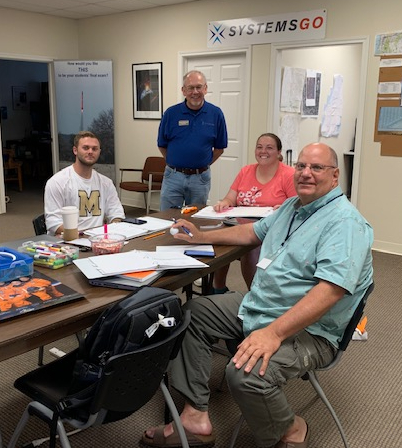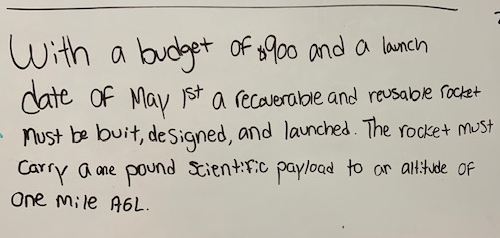A 7:00 a.m. call to move out for ABC-1 started the day for all SystemsGo team and schools. The mission, to accomplish all preparations for tomorrow’s launches. All personnel arrived at the site at 8:15 am and quickly began preparations.
Scott Netherland, George Burns and Ginger Burow set up the electronics trailer and the fill and fire system. Steve Burow set up the pad, rails and wiring for the launch rails. Students from the teams helped erect the rails before finishing work on their vehicles.
Rebekah Hyatt and Andrew Matthes coordinated all the final checks for each of the rockets, while students worked through their Flight Readiness Reviews. WSMR range personnel assisted the team.
Three graduates from Hamilton High School, Caleb Lengefeld, Kash Kneuper, and Taylor Long, volunteered to help on range. It was their first time to see what the Goddard program was really like. They were students of the program but did not get to do Goddard due to financial constraints at their school. They helped set up the pad, load the gas tank truck, and helped with pressure checks during the FRR’s for each rocket. For launches tomorrow they will assist as needed at the pad and manhandle Nitrous and Gox bottles. All three said they were really enjoying seeing the program in action, helping with it and learning new things about how it works.
Schools Participating are Alamo Heights, Union Grove, Fredericksburg, and Brazoswood. Fredericksburg and Union Grove were fit with charges and loaded onto the rails for launch tomorrow morning. Brazoswood and Alamo Heights will load pyros in the morning.
Pop up showers passed around the site to the south throughout the day, occasionally dropping spotty drizzle. Mostly they just kept the temperatures out of the 100’s and produced a cool breeze which was most appreciated. WSMR personnel reported that there could be a delay due to storms in the morning. We are hoping they will pass through before our T times.
The caravan of 17 vehicles plus WSMR personnel vehicles left the test site by 5:15 headed in for the evening. Food and showers were top priorities upon returning to the hotels.
Launch order for Saturday is as follows:
- Union Grove
- Fredericksburg
- Alamo Heights
- Brazoswood
Saturday’s schedule is the following:
- Saturday, June 25th
- Launch Day (All Four Rockets, if possible, at 2-hour intervals.)
- Depart from WSMR Rt 21 gate by 5:00 a.m. for 6:30 a.m. arrival on site.
- Projected launch schedule:
- T1 8:00 am. -Union Grove
- T2 10:00 am. -Fredericksburg
- T3 12:00 pm. -Alamo Heights
- T4 2:00 pm. – Brazoswood
- 5:00 pm. – Range Time Ends
SystemsGo now has two launch rails and both will be in operation tomorrow. A rocket will be loaded onto each rail and then tested in sequence with only time out for safety. The launch team will be required to evacuate during each launch; and then return to swap out gas and electrical connections between the rails.
Launches are to commence at 8:00 am. Saturday morning. All SystemsGo personnel and schools will be headed out to the range at 5:00 am.
After the first two launches, WSMR personnel will attempt to locate and retrieve the rockets for the students while the other two rockets are loaded onto the rails. Mission complete will be at 5:00 pm. and all personnel must leave the range. If all four launch on time then everyone will be asked to help tear down and pack up equipment before leaving. If this is not accomplished by range end time it would mean returning on Sunday to complete it.
Realistically, this is a very tight launch sequence with little to no room for errors. As we know, errors can and do occasionally happen and can cause severe delays in the launch schedule and hinder time availability.
If we do not get all four launches done tomorrow, we do have Sunday as a contingency day with a similar time schedule as Saturday’s as allowed by WSMR. It is preferable to not have to use Sunday for more than clean up if at all.
Best of luck to all schools so that they may have a successful launch tomorrow.
Event details will continue to be available here. I will provide more information each morning as to how the schedule and other event details will progress for that day and how launches went for the schools testing that day. Pictures are not allowed on the range, but some pictures of teams getting ready to leave for the range with their vehicles might be available. If anything is available I will post it for your viewing pleasure.
www.systemsgo.org as always is the place for more information on this program. You may also email them at info@systemsgo.org. Take the time to get your school involved, the future of your students will be greatly benefited.
#Rockets2022 #SystemsGo #RideTheSky #Texasrockettrail #WSMRRocketLaunch2022






































